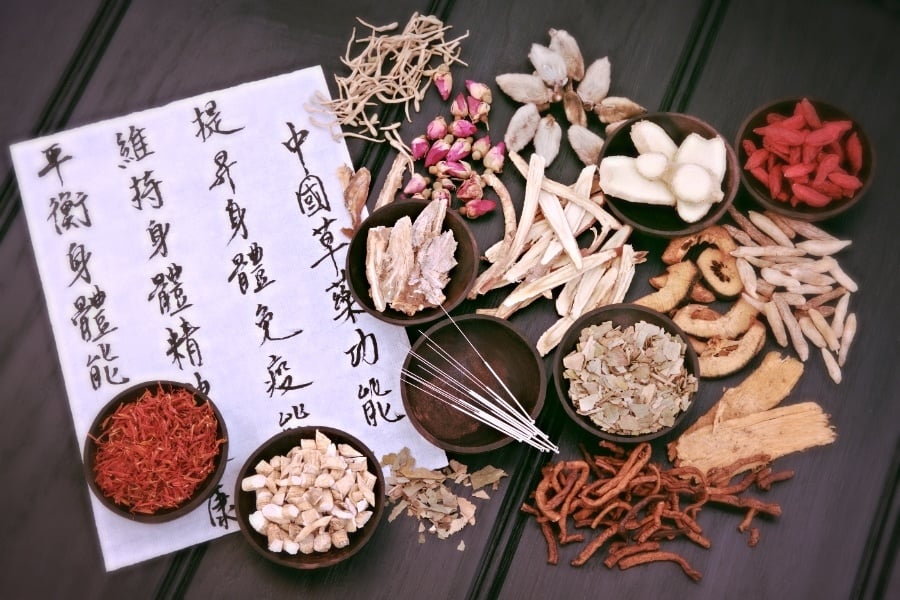
Before I started the master’s degree program at AOMA, I did not realize the degree to which herbal studies would be a major part of what I would learn in acupuncture school. It turns out that Chinese medicine is a vast field that encompasses much more than just the practice of acupuncture. In fact, herbs are an important facet of how we as acupuncturists help our patients get to a better state of health. They can be used in addition to acupuncture or as a stand alone treatment and they are an important staple of Chinese Medicine. So, in honor of being “in the know”, here are 5 things you may not have known about herbal studies here at AOMA!
- You don’t need to read Chinese to study Chinese Herbs: The herbs you learn about here at AOMA are all named in Pinyin- the phonetic system for transcribing the Mandarin pronunciations of Chinese characters into the Latin alphabet. For instance, we learn fresh ginger as “Sheng Jiang” and ginseng is “Ren Shen”. Often times, the pinyin names give a description of the herb itself, like Da Huang translates to “Big Yellow” in English. It is a very powerful herb that is yellow in color. Wu Wei Zi translates to “5 flavored seed” because this herb is said to contain all the 5 flavors in Chinese Medicine- sour, bitter, sweet, salty, and pungent.
- Herbs can multi-task: Some herbs are highly versatile and can treat a wide range of illnesses and health issues. Many times, it is baffling how many seemingly unrelated illnesses one herb can help treat. For instance, Huang Qi, one of the most commonly used herbs in Chinese Medicine, can be used to treat bleeding disorders, general fatigue, organ prolapse, dizziness and vertigo, the side effects associated with radiation and chemotherapy, excess leakage of body fluids (like profuse sweating and urine due to deficiencies), compromised respiratory and digestive function, chronic sores and ulcers, various types of edema, numbness and pain experienced because of lack of blood flow to extremities, post stroke complications, and the wasting and thirsting symptoms of diabetes. Yet, this speaks to the complexity of natural substances made up of a myriad of compounds. And in combination with other substances, there is a synergistic effect that focuses on the target – the condition being treated.
- Not all herbs are plants: Some herbs used in Chinese medicine are in fact, unfathomable under common notions about what comprises “herbal medicine”. Certain insects make it onto the list of important herbs used in Chinese medicine. For instance, Ban Mao is derived from a type of beetle and can be used to treat various skin conditions. Also there is Ge Jie, which is derived from a type of gecko. Ge Jie is great for treating chronic cough, weakness and soreness in the lower back and knees, impotence, and diarrhea. Yes, it is a little gross to imagine ingesting these things, but they can be very helpful to some of our patients.
- You can find many Chinese herbs at your local grocery store: Goji berries or Gou Qi Zi are really great for brightening eyes and treating blurry vision. With other herbs Gou Qi Zi can also treat great for dizziness, lower back weakness, night sweats, and tinnitus. Also, if you ever eat pho, a type of noodle soup, you are probably eating Zi Su Ye or Purple Perilla Leaf. This herb is not only tasty, it helps treat certain types of colds, alleviates nausea, vomiting, and seafood poisoning, and it helps quell morning sickness. Gui Zhi or cinnamon twig is also a Chinese herb that treats pain, edema, dysuria, irregular menses, and is commonly used today to treat myocardial infarction, angina pectoris, and cardiac insufficiency.
- It matters what part of the herb you use: Different parts of the same plant can be different herbs with different qualities. For instance, Ma Huang, also known as Ephedra sinica, is the body (aerial or above ground portion) of the plant and treats the common cold by opening the pores and allowing a slight sweat, stops cough, relieves edema, and warms the body. Ma Huang Gen, on the other hand, is Ephedra sinica root, and only treats the symptoms of excess sweating. Further, in Chinese medicine, these different parts of the same plant treat opposing problems- Ma Huang releases the exterior while Ma Huang Gen does the opposite by stopping sweating.
Through AOMA's challenging graduate program I have been able to learn extensively about herbs and their uses, furthering my own practice in Chinese Medicine. Here at AOMA, graduate students complete over 500 hours of herbal education and take courses such as Herb Singles, Herbal Formulas, and Herbal Treatment of Disease. Though these courses can be difficult, they are also very valuable in an acupuncture practice. And no, I am not going to explain what “releasing the exterior” is. I will leave that for when you come to herb class!


